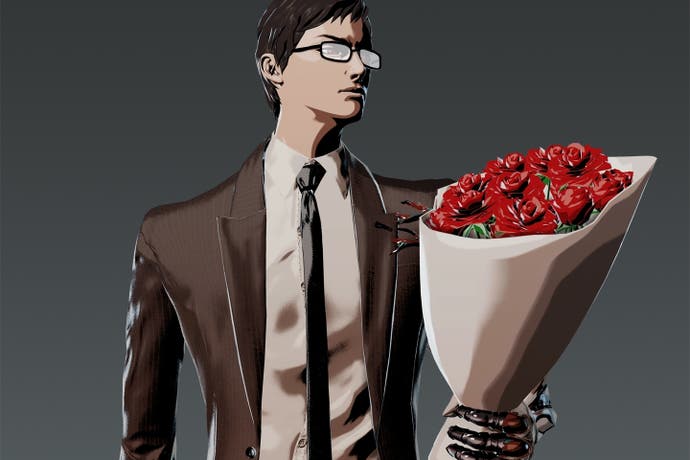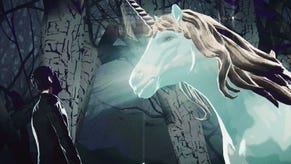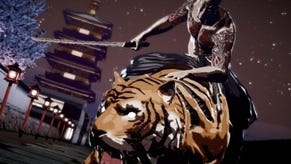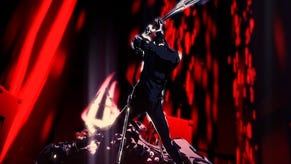Killer is Dead review
And so is punk.
To what extent is Goichi Suda still making the games that bear the Suda 51 hallmark? It's hard to tell. The affable punk stylist of the Tokyo games scene hasn't taken a director credit since 2008. Usually referred to as creative or executive director, sometimes taking a scenario or scriptwriting credit - and always happy to speak to the press as the cool figurehead of his studio, Grasshopper Manufacture - Suda's style is unmistakable, but his personal creative input is increasingly opaque.
The firebrand of the mid-2000s who made the hypnotically strange Killer7 and the anarchic No More Heroes has turned himself into a sort of anti-establishment brand, like a fashion designer, leaning on borrowed rebel rock riffs. The games, always rough, have started to look rote with it. The amusingly schlocky Shadows of the Damned and Lollipop Chainsaw are now followed by Killer is Dead, a zany action game directed by Hideyuki Shin which rather self-consciously recycles the look and themes of Suda's more fondly remembered cult hits.
Once again, then, we take the role of a devil-may-care assassin inhabiting a wild comic-book reality where anything can happen: nursery-rhyme horror, giant mutants, sentient trains, possessed Yakuza, unicorns, mansions on the moon, the works. Mondo Zappa glides through all this chaos in a sharp suit, slashing at robotic enemies with his katana or shooting at them with his cybernetic arm, looking cool in the colour-saturated, high-contrast, cel-shaded visuals.

If story is Suda's primary responsibility these days then he can certainly be commended for his scattershot enthusiasm and unconcern for making any sense. Mondo is dispatched on execution missions - all of which end with him decapitating his mark while solemnly reciting the game's title - by a jocular, cigar-smoking cyborg called Bryan and a lady motorcyclist who likes to leave her jumpsuit open to show her bra. Mondo also has a squeaking, girlish "assistant" called Mika who begins the game, dubiously, in his bed. This motley band of hitmen take contracts for money but also claim to work for "the state". Though each mission's relationship to the last is one of total incongruity, there is a thread of sorts, which involves a character that appears to be Audrey Hepburn in Breakfast at Tiffany's - she's even called Moon River - asking Mondo to kill the king of the moon, whose name is David and who dresses like Lady Gaga.
Killer is Dead suffers from a near-total lack of purpose or theme which leaves it as little more than a jumble of random imagery and camp dialogue
This all sounds like a lark, and it sort of is, but Killer is Dead suffers from a near-total lack of purpose or theme which leaves it as little more than a jumble of random imagery and camp dialogue with a few painfully clumsy winks at the camera to excuse it away. Its only consistent aim seems to be an oddly earnest attempt at a B-movie psychological thriller, as Mondo - an amnesiac, naturally - connects fragments of his past to the half-articulated melodrama flapping weakly at the game's centre. This results in a couple of quite memorable dream sequences, including one boss fight where the camera intermittently switches to the view out of your opponent's eyes - a neat trick. But Mondo is a paper-thin and slightly dour character - he certainly has none of Travis Touchdown's impish charisma - and he can't sustain the attention.
He is in no way helped by Killer is Dead's one heinous error of judgment. Alongside a few side missions of very variable quality, Grasshopper has seen fit to include "gigolo" missions in which you attempt to bed a series of lovelies. These seedy vignettes are deplorable, excruciatingly embarrassing, and no fun to play.

Having pored over your date's "lady details" on the intro screen, you view her in first person and attempt to raise your "guts meter" until you are sufficiently brave to give her a present. This is done by gazing into her eyes or, while she's not looking, staring at her breasts or crotch for a "sexy shot". If she catches you checking her out, you lose guts. If you get enough ogling done to raise your guts (measured, ickily, in fluid ounces) you can give her a present and fill some hearts. Fill all her hearts and she'll lead you off screen - and reward you with a new weapon for your romantic attentions.
You have no dialogue options at all; Mondo never says anything, in fact, while the girl will mindlessly repeat two or three phrases about what a great time she's having. It makes the sterile romance scenes in BioWare games look like Casablanca. It's sexist, it's grubby, it's voyeuristic and objectifying, and it's also a sad, lopsided and profoundly unsexy depiction of romantic interaction. It's not even funny - and the basic and boring gameplay, which mostly consists of waiting, certainly does nothing to redeem it.
Gigolo mode is presumably intended to portray our hero as a Bond-style playboy, but instead he comes across as a pathetic, socially impaired creep
Gigolo mode is presumably intended to portray our hero as a Bond-style smooth international playboy, but instead he comes across as a pathetic, socially impaired creep who has to bribe women for sex. How it didn't end up cut from the game is unthinkable. Fortunately, there's no real need to complete these missions, so you can do the producers' job for them and ignore them.
It's a shame the production time wasted on this garbage wasn't spent on the core gameplay of Killer is Dead instead, because this is a solid swordfighting action game; generic, not particularly sophisticated, but presented with a gratifying, rhythmic flair. There's only one attack button to combo with, while the guard mechanic - whether using Mondo's own defensive stance, or breaking his enemies' - is a bit stodgy. But pressing guard with a direction performs a usefully rapid dodge which can be used to flank enemies and which, if timed just right, stops time and allows you to mash away at the attack button for extra damage.
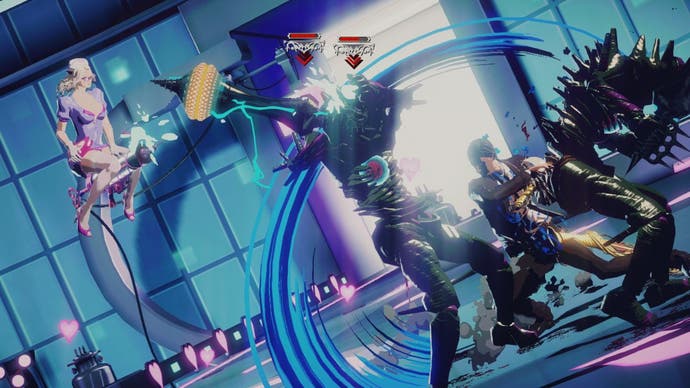
Shooting - performed over the shoulder - is less refined and not particularly well integrated, but it works well enough, and the controls are snappy. Shooting and finishing moves consume Blood, which can also be used to replenish health; your health and Blood can be upgraded as you play, and you can buy new moves, abilities and buffs. The mechanical knights you mostly face aren't that varied in their tactics, but they can and do damage each other, and it's fun to manipulate them into taking each other out.
Although hardly operating at the level of Platinum Games, in Killer is Dead Grasshopper has achieved a decent, mechanically sound action game that could have been lifted above the average with a little more time spent: on the moveset, on more varied and ingenious enemy designs, on levels that didn't belie their outlandish concepts with featureless, repetitive layouts. A little technical polish wouldn't have hurt, either. On Xbox 360, Killer is Dead has some of the worst screen tearing I've ever seen - a constant, ugly shear which ruins the integrity of the otherwise striking visuals.
If punk is about ignoring rules, trashing conventions and working fast and rough to access the raw energy of your art, then No More Heroes, at least, was truly a punk game - and on the strength of that, Suda can lay a legitimate claim to the term. But too many more lazy games like Killer is Dead, which is crazy for the sake of it and shoddy because it's cheaper to cut corners, and he'll lose the right to use it.
At various points, Killer is Dead shoots for the visual surrealism of El Shaddai, the hyperbolic intensity of Asura's Wrath, the oddball melodrama of Deadly Premonition, the extravagant showmanship of Bayonetta. It misses by a wide margin every time. Those games are punk, but Killer is Dead is just posturing. It's just product.
